GMX is currently the largest Defi platform on Arbitrum today, with a unique mechanism to help support liquidity and optimize profits obtained through Real Yield. However, as Holdstation has many times mentioned, providing liquidity on GMX with GLP tokens also has many risks of price manipulation, bringing many losses to participants.
Watch more: Delta-Neutral Yield? The New Force on Arbitrum
Accordingly, Level Finance was created as a solution to minimize the above risks. This can be seen as a fork (simulation project) of GMX on the BNB Chain, accompanied by many improved mechanisms when providing liquidity and risk management.
How does this project stand out from the many projects using the same mechanism as GMX?
What is Level Finance?
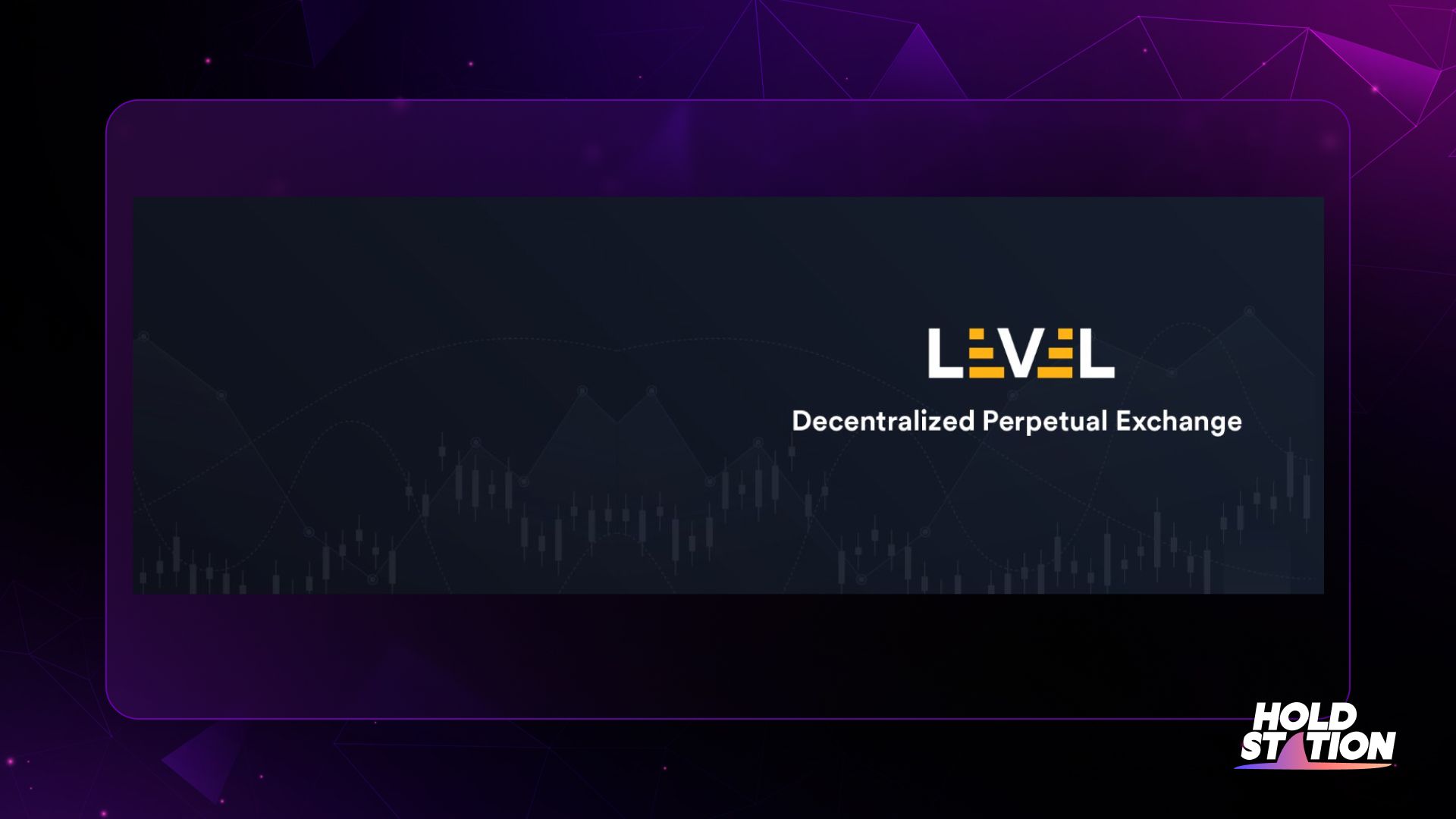
Overview
Level Finance is a new DEX built on BNB Chain, offering spot (Spot) and perpetual contract (Perpetual) trading with up to 30x leverage.
With many similarities to GMX, Level Finance also offers low fees, zero price impact, price information is updated instantly based on Chainlink Oracle, and not to mention the Real Yield mechanism that has already been implemented. too familiar with today's decentralized exchanges.
With just the mainnet on December 26, 2022, let's take a look at what Level Finance currently has.
Tokenomic
Level Finance uses 2 main tokens, $LVL (utility token) and $LGO (Governance token). In addition, when users provide liquidity to the platform, they can receive LLP tokens (Level liquidity provider).
- $LVL Token
The $LVL token is a utility token of the Level ecosystem with a total supply of 50,000,000 tokens. $LVL is mainly used for the purpose of compensation: to pay rewards to liquidity providers, to the community, to strategic partners, and to the project itself.
Currently with a total supply of 50,000,000, the token price fluctuates at 0.4 USD, the market capitalization is reaching 20 million USD, a relative number compared to a new project launched on December 26.
However, one thing to note about $LVL's token allocation ratio is that Team and strategic partners account for a total of 30%. This division allows the project to hold a relatively high amount of tokens compared to new DEXs using the Real Yield mechanism, but the lock time of this token is also quite long (Team token will be locked for 4 years, unlocked ¼ tokens every 12 months) thus also controlling the risk.
- $LGO Token
The project's governance token, $LGO, is a token with a total supply of 1000, which can ONLY be obtained when staking $LVL. The $LGO token holders will be considered shareholders of the project, and will later receive the corresponding benefits that the project commits to bring.
Level DAO
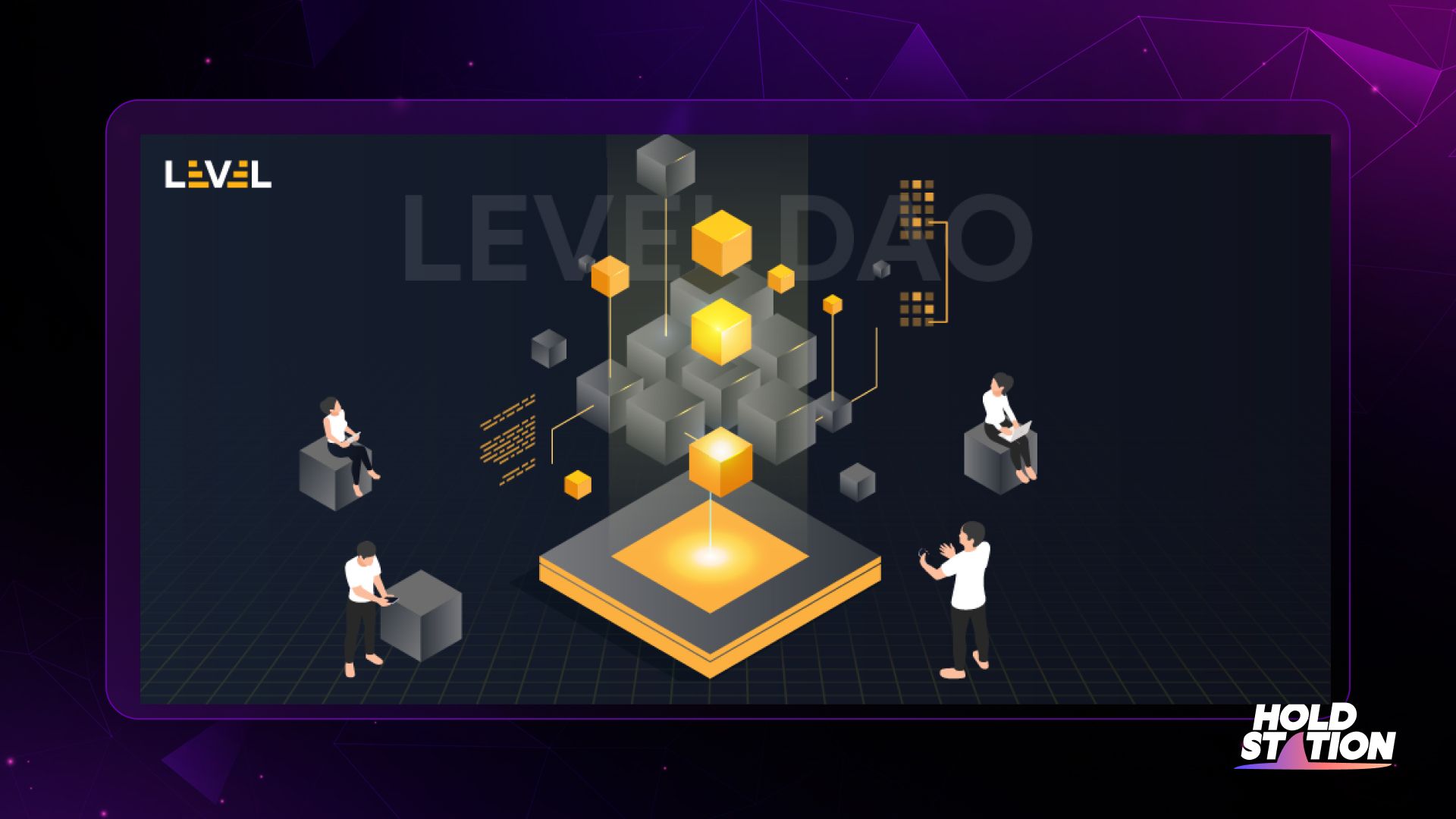
Level DAO (Decentralized Autonomous Organization) is deployed to decide the spending from the liquidity pool, treasury, and fees collected from actual profits through the governance token, $LGO. With this governance token that can only be obtained when staking $LVL, users can compete for the right to manage the project fairly, even holding the majority of control.
This also means that the project itself must continue to participate in staking (after the vesting ends) to get the $LGO token, thereby participating in a part in the management of this fund. In general, this will be the fairest method for users to avoid too much influence from the project.
What really makes Level Finance different?
In order for a decentralized exchange to develop with a long-term orientation, focusing on the development in one segment will help the project stand out and stand out in the current time with so many projects also in progress.
Level Finance is introduced with outstanding features in the mechanism, helping users to truly manage risks when providing liquidity to the exchange, thereby allowing them to earn more passive income.
Accordingly, Level Finance introduces two main mechanisms to help promote liquidity and, at the same time, help users manage liquidity.
Mechanism of using index token LLP (index token)
Token $LLP (Level Liquidity Provider) is Level Finance's liquidity provider token. When users provide liquidity to the system, this money will be used to buy corresponding assets, including $BTC, $ETH, $BNB, $CAKE, $USDT and $BUSD. At the same time, users will be paid the corresponding amount of LLP tokens, which can be staked to receive rewards.
This mechanism is exactly the same as the liquidity-providing token for GMX, $GLP. This will generally have a great advantage with the removal of price impact, as the token is based entirely on the price offered by oracle while providing diversity in the project's portfolio. judgment.
Risk management mechanism using Tranche
Tranche is a familiar financial instrument to the traditional financial industry, the essence of which comes from dividing assets (similar to mortgage securities) into portfolios with different risks and rewards. to meet individual needs and diversify investment portfolios.
Similarly, Level Finance's liquidity pool is divided into 3 tranches, each with different risk and APR, depending on the taste of each investor.
- Senior Tranche (AAA) — lowest risk and lowest APR
- Mezzanine Tranche (AA) — moderate risk and average APR
- Junior Tranche (BB) — highest risk and
Each Tranche has its own liquidity provisioning price (LLP token price per Tranche). This price will fluctuate over time based on the level of risk as well as market price fluctuations, depending on the ratio of the respective security assets.
Let Holdstation analyze the actual risk level of each Tranche below.
As mentioned above, the LLP token comprises the assets ratio of the tokens $BTC, $ETH, $BNB, $CAKE, $USDT, and $BUSD. Where $BUSD and $USDT are two stablecoins, they do not affect the price of the token. The remaining factors, including $BTC, $ETH, $BNB, and $CAKE, are the tokens that cause price fluctuations, changing the value and risk of each Tranche.
The chart below shows the risk per Tranche for each of the volatile tokens $BTC, $ETH, $BNB, and $CAKE.
According to the table above, it can be seen:
- Senior Tranche has the lowest risk because this Tranche only owns 3 main tokens, $BTC, $ETH and $BNB. These 3 tokens have the main characteristics of large capitalization, high value and best stability.
- In Mezzanine Tranche, can be said to be a balanced Tranche with equal risks from the constituent tokens.
- Junior Tranche is the Tranche with the highest risk, also the Tranche that has the most $CAKE tokens and the fewest $BTC tokens, so the risk of volatility is greater than the rest of the Tranches.
The mechanism of splitting these Tranches, plus the liquidity supply mechanism of LLP tokens, is a special feature that sets Level Finance apart from other common DEXs.
From an objective point of view, Holdstation will explain in more detail how these two mechanisms work together to manage risk while ensuring profits for the following liquidity providers.
How Level Finance works for users and liquidity providers
Provide liquidity to Level pool
Liquidity providers who place their assets in the liquidity pool will immediately be converted into LLP tokens at a price corresponding to the Tranche they choose. This price may fluctuate depending on the cost of the constituent tokens. and profit earned.
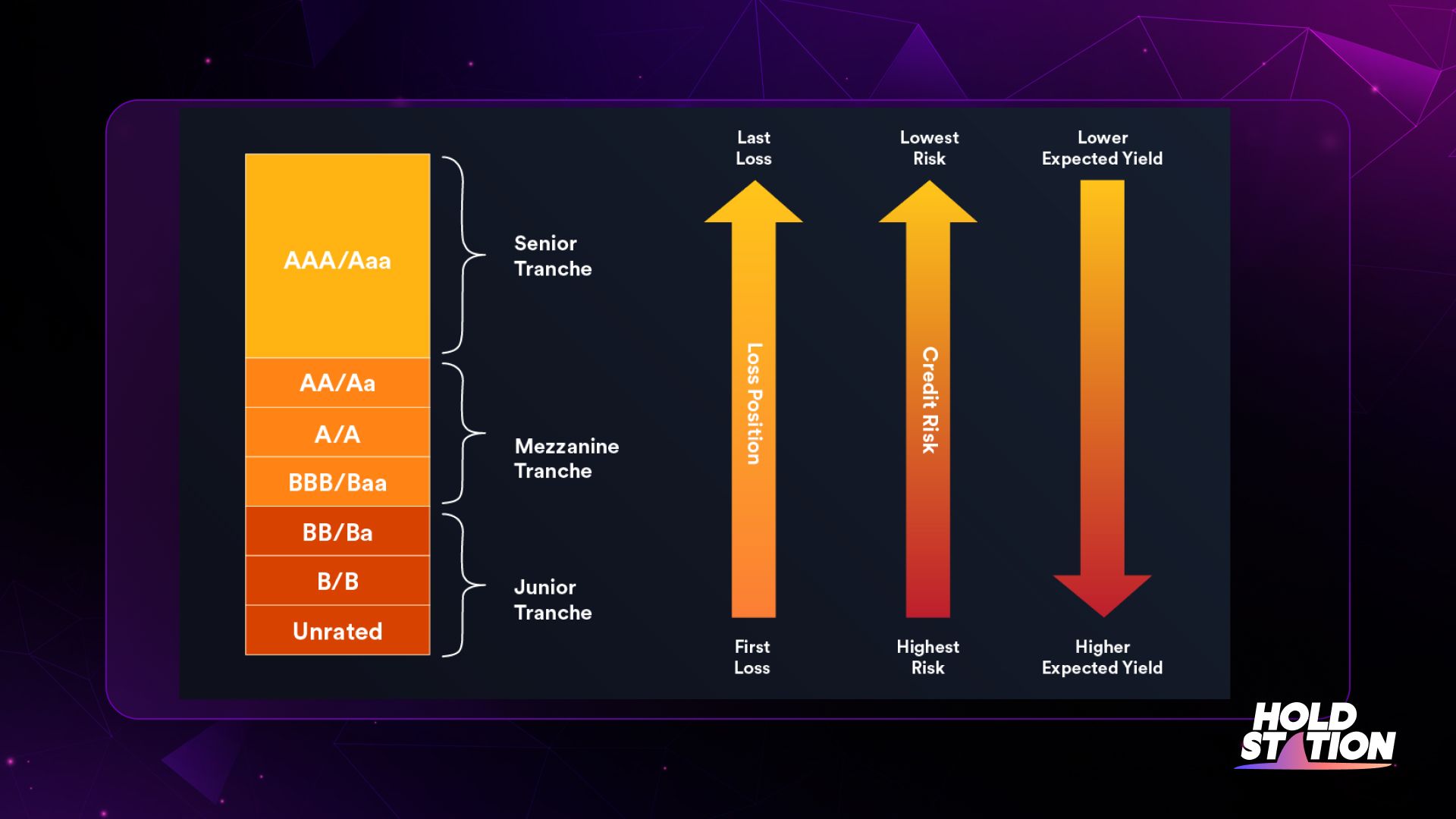
By converting assets into LLP tokens, means that the amount of assets will be distributed in proportion to the tokens listed as LLP tokens, with 44% being stablecoins and 56% being other tokens.
For example, Holdstation puts 100 USD into the Junior Tranche pool, in exchange for about 105 Junior LLP tokens (with the current Junior LLP token price of 0.954 USD). The amount of 100 USD assets will be redeemed by the $BTC, $ETH, $BNB, $CAKE, $USDT and $BUSD redemption protocol, respectively, into the general liquidity pool of Level Finance.
105 Junior LLP tokens after receiving can continue to be staked to receive APR up to 1,140.39% (corresponding to each day the project will deduct 20,000 LVL to reward Junior Tranche, the APR changes based on the price of the Junior Tranche. LVL)
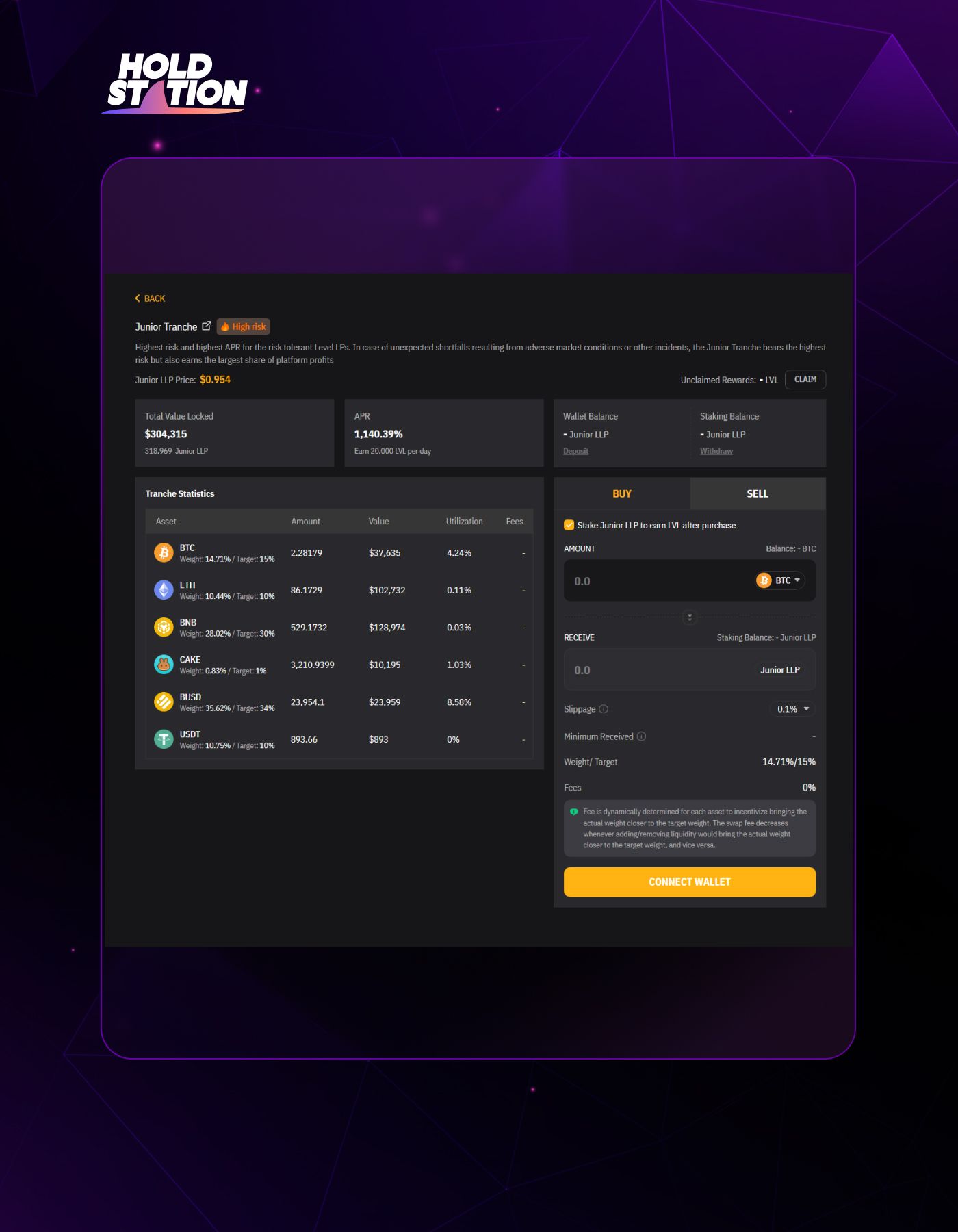
The amount of $LVL to receive rewards can continue to be staked to obtain the $LGO governance token.
Trader and liquidity provider Interaction
First, let's take a look at the token allocation table for each Tranche below.
Suppose Trader A plays Future on Level Finance and opens a 150 BTC position. To ensure liquidity is available for transaction settlement, the Level protocol will need to reserve a total of 150 BTC in a liquidity pool allocated as follows:
- Senior pool: 150 x 40% = 60 BTC
- Mezzanine pool: 150 x 35% 52,50 BTC
- Junior pool: 150 x 25% = 37,5 BTC
Result 1:
A is a pro trader who won and got a profit of 10 BTC on his 150 BTC position. In other words, A decides to pay out (close the position) his 150 BTC trade and set a profit of 10 BTC. Conversely, the Level Liquidity Provider (LLP) will incur a loss of up to -10 BTC. After that, 10 BTC will be withdrawn from the liquidity pool and paid to Trader A's balance as follows:
- Senior pool: -10 x 40% = -4 BTC
- Mezzanine pool: -10 x 35% = -3,5 BTC
- Junior pool: -10 x 25% = -2,5 BTC
Total: -10 BTC (loss for the liquidity provider for Level, gain for Trader A)
Result 2:
A is an amateur trader who lost 20 BTC on his 150 BTC position. In other words, A decided to pay out (close the position) his 150 BTC trade and take a loss of 20 BTC. In contrast, the Level Liquidity Provider (LLP) will get a profit of up to 20 BTC. After that, 20 BTC will be deposited into the liquidity pool and taken from Trader A's balance as follows:
- Senior pool: 20 x 40% = 8 BTC
- Mezzanine pool: 20 x 35% = 7 BTC
- Junior pool: 20 x 25% = 5 BTC
Total: 20 BTC (profit for the liquidity provider for Level, loss for Trader A)
It is clear that liquidity provision is a bet between liquidity providers and position openers. However, instead of before, the liquidity provider's risk only fluctuates at one level. Dividing into many Tranche will help them better manage risk, and at the same time can invest in many different assets. portfolio to optimize profits.
Risk management is also pushed up because unlike GMX, the diversification of Tranche will help users invest in Tranche with a high level of safety, including large-cap tokens, thus completely avoiding manipulation. poor price like GMX floor has been in the past.
See also: Price Manipulation on GMX - How Whales Exploited This Vulnerability?
Level Finance has growth potential?
DEX project on BNB Chain
Level Finance is built on BNB Chain, this Blockchain has an undisputed appeal to traders. At the same time, there are not many DEX exchanges on BNB Chain at the moment, the growth potential is extremely large with Binance's hints about investing in decentralized exchanges in the near future.
Currently, comparing blockchains, BNB Chain is ranked 2nd in TVL with $4.97 billion.
Innovation in the mechanism
Instead of being a fork entirely from GMX, Level chose to dive into risk management, as mentioned above. This completely gives users a new option in creating a sustainable passive income source, allowing users to select the direction that suits their investment goals as well as their risk tolerance. Its property.
This main difference sets Level Finance apart from projects that copy the GMX mechanism, which already has a foothold in the current market.
Real Yield
As mentioned in the Whitepaper, the fees collected by the platform will be swapped into one of the tokens, such as $BTC, $ETH, $BNB, $USDC, or $DAI, thereby rewarding liquidity providers. and Treasury of the DAO. This is one of the basic mechanisms that bring constant profits to users, also known as Real Yield.
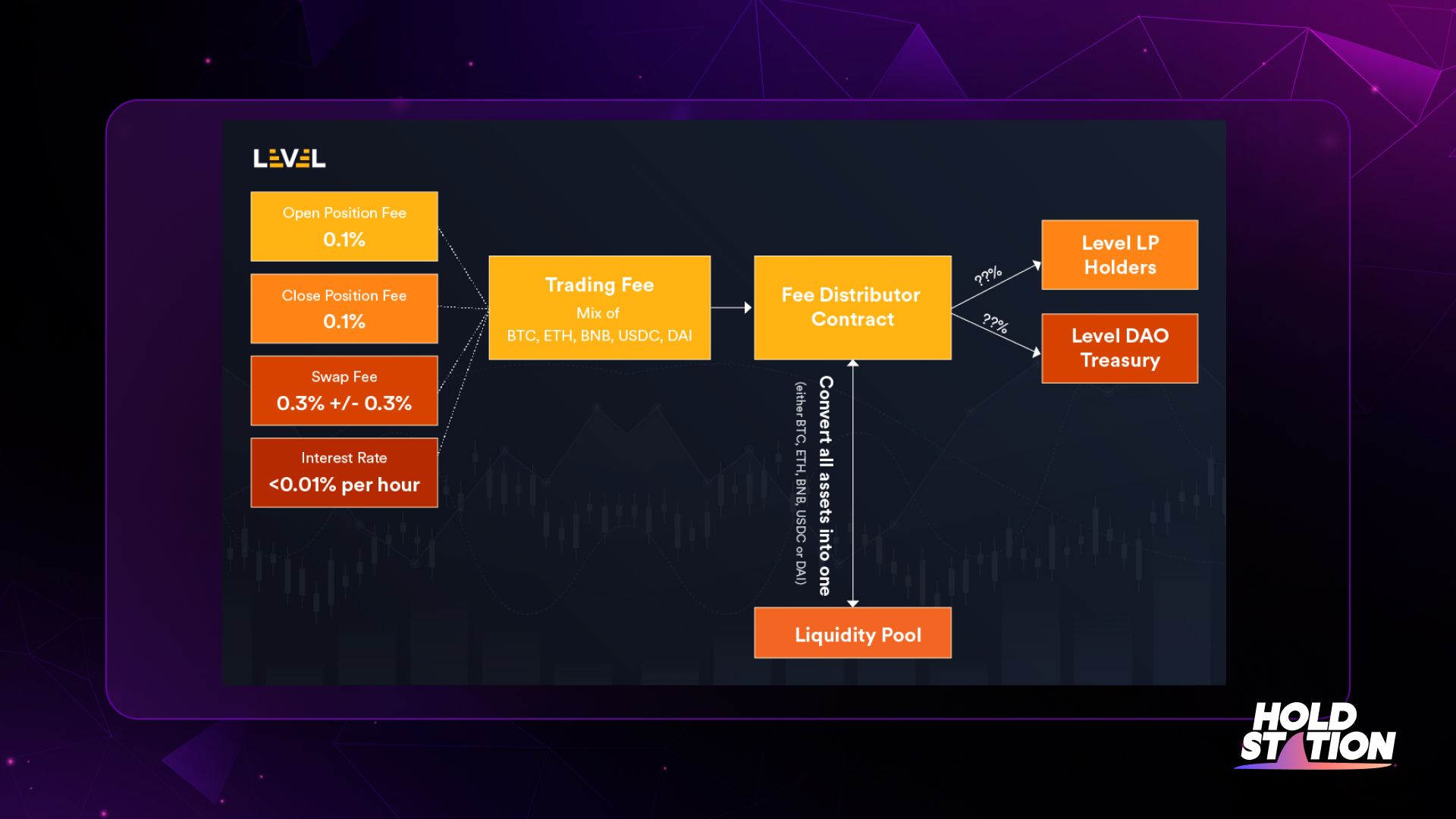
TVL and $LVL token price
Reflecting a large part of the efficiency of a DEX can include the total value of locked assets (TVL) that the project owns.
Level Finance's TVL is currently about $1,358,100, an increase of nearly 4 times compared to before December 26, after the official mainnet. This is an impressive growth rate in the context of the current downward trend of the market.
The LVL token price also demonstrates the potential of this project. Currently, LVL is trading on PancakeSwap at $0.18, peaking at $0.63, increased 50% from its previous low on Dec. 27 at around $0.12.
Currently, the LVL token has quite a few big waves, most of which come from the FOMO of the market. However, according to Holdstation, this increase in the near future will continue because currently, not too many people know about this project, and the interactions on Twitter are still quite low.
Summary
With the above information, it is possible to believe in the growth potential of Level Finance. However, as it is still quite new, Holdstation will continue to put this project on the watch list and will inform you as soon as possible.
💜🦈 Holdstation Wallet - Your Gate to Web3
Make DeFi as easy as CeFi!
📲 Download now: IOS | Android
Disclaimer:
The information, statements and conjecture contained in this article, including opinions expressed, are based on information sources that Holdstation believes those are reliable. The opinions expressed in this article are personal opinions expressed after careful consideration and based on the best information we have at the writing's time. This article is not and should not be explained as an offer or solicitation to buy/sell any tokens/NFTs.
Holdstation is not responsible for any direct or indirect losses arising from the use of this article content.

